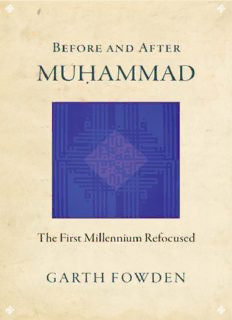
Before and After Muhammad: The First Millennium Refocused PDF
Preview Before and After Muhammad: The First Millennium Refocused
H BEFORE AND AFTER MU AMMAD H BEFORE AND AFTER MU AMMAD THE FIRST MILLENNIUM REFOCUSED Garth Fowden PRINCETON UNIVERSITY PRESS PRINCETON AND OXFORD Copyright © 2014 by Princeton University Press Published by Princeton University Press, 41 William Street, Princeton, New Jersey 08540 In the United Kingdom: Princeton University Press, 6 Oxford Street, Woodstock, Oxfordshire OX20 1TW press.princeton.edu All Rights Reserved ISBN 978-0-691-15853-2 Library of Congress Control Number 2013942727 British Library Cataloging-in-Publication Data is available This book has been composed in Garamond Premier Pro Printed on acid-free paper. ∞ Printed in the United States of America 1 3 5 7 9 10 8 6 4 2 aug. mmix Contents PREFATORY NOTE AND ACKNOWLEDGMENTS ix ABBREVIATIONS xi Chapter 1. INCLUDING ISLAM 1 The West and the Rest 1 Edward Gibbon 5 Islam and late Antiquity 9 Summary 15 Chapter 2. TIME: BEYOND LATE ANTIQUITY 18 The roots of late antique studies 18 Burckhardt to Strzygowski 23 The Orient and Islam: Views from Vienna 30 Pirenne to the present 37 Chapter 3. A NEW PERIODIZATION: THE FIRST MILLENNIUM 49 Decline versus transformation 49 Maturations 53 Monotheist historiography 68 For and against the First Millennium 82 Chapter 4. SPACE: AN EASTWARD SHIFT 92 Discovering the Mediterranean 92 Discovering the East 96 Empires and commonwealths 101 The Mountain Arena 116 Chapter 5. EXEGETICAL CULTURES 1: ARISTOTELIANISM 127 Greek Aristotelianism 129 Christian polemic 136 Aristotle in Latin, Armenian, and Syriac 139 Alexandria to Baghdad 146 Arabic Aristotelianism 153 Chapter 6. EXEGETICAL CULTURES 2: LAW AND RELIGION 164 Roman law 166 Rabbinic Judaism 173 Patristic Christianity 181 Islam 188 Chapter 7. VIEWPOINTS AROUND 1000: ṬŪS, BASRA, BAGHDAD, PISA 198 T ūs/Iran 199 s Ba ra/Encyclopedism 204 Baghdad/Rationality 207 Pisa/The Latin West 212 PROSPECTS FOR FURTHER RESEARCH 219 MAP: THE EURASIAN HINGE, WITH CIRCUM-ARABIAN TRADE ROUTES 106 INDEX 225 Prefatory Note and Acknowledgments h Before and after Mu ammad develops my attempt in Empire to commonwealth (1993) to view Arsacid and Sasanid Iran, Rome, and the Caliphate within a single frame. Since then I have approached the early Caliphate by way of its material culture in Qusayr ʿAmra (2004), and through philosophy (especially the Arabic Plotinus) in an uncompleted book titled Rational Islam and the reinvention of Aristotle. Except in its h definition of the geographical framework, Before and after Mu ammad barely overlaps with Empire to commonwealth; but it has been much fertilized by Rational Islam. It lays out, and in its last two chapters somewhat schematically exemplifies, a new historical periodization, whose practical demonstration will be provided, in due course, by a large-scale narrative to be titled The First Millennium: From Augustus to Avicenna. Unless specified otherwise, all dates are CE, and translations listed in the notes are into English. There is no bibliography. All references are given in full at their first occurrence and in abbreviated form thereafter, with their first occurrence indicated in square brackets by chapter and footnote number separated by a colon (e.g., [2:32]). The chapter 2 epigraph excerpt is reprinted by permission of the publisher from Interpreting late Antiquity: Essays on the postclassical world, edited by G. W. Bowersock, Peter Brown, and Oleg Grabar, p. ix: Cambridge, Mass.: The Belknap Press of Harvard University Press, Copyright © 1999, 2001 by the President and Fellows of Harvard College. The chapter 5 first epigraph excerpt is from Sebastian Brock’s article “From antagonism to
Description: